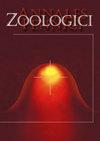Occurrence of Two-Year Cyclicity, “Saw-Blade Fluctuation”, in Vendace Populations in Finland
IF 0.9
4区 生物学
Q4 ECOLOGY
引用次数: 4
Abstract
The tendency towards two-year cyclicity is considered typical of many Fennoscandian vendace populations, especially in fluctuation of recruitment, based on time series of individual lakes. We used two robust indicators to identify and quantify two-year cycles in vendace population proxy time series at different life-stages — spawning stock biomass (SB), density of newly hatched larvae (LD) and recruitment (REC) — from 22 Finnish lakes. Then we applied Fisher's meta-analytical test to assess the adequacy of the evidence to support the hypothesis that vendace population dynamics include two-year cyclicity. The results supported this hypothesis for REC but not for SB or LD. Yet, the indicators and test are conservative and time-series of SB and LD are shorter than those for REC. The appearance of cycles in REC is associated with high post-recruitment mortality, consequently practically only one spawning per cohort. Cycles may be typical for the recovery period from low abundance period also. Still, some populations with moderate post-REC mortality and non-cyclic SB abundance exhibited cycles in REC. Such dynamics presuppose the existence of more complex regulation based on the interaction of different life stages.芬兰Vendace人群两年周期性“锯片波动”的发生
两年周期性的趋势被认为是许多芬诺斯堪的纳维亚vendace种群的典型趋势,特别是在基于单个湖泊的时间序列的招募波动中。我们使用两个稳健的指标来识别和量化芬兰22个湖泊中不同生命阶段的vendace种群代理时间序列的两年周期——产卵种群生物量(SB)、新孵化幼虫密度(LD)和繁殖(REC)。然后,我们应用Fisher的元分析检验来评估证据的充分性,以支持vendace种群动态包括两年周期性的假设。结果支持REC的这一假设,但不支持SB或LD。然而,指标和测试是保守的,SB和LD的时间序列比REC的时间序列短。REC中周期的出现与招募后的高死亡率有关,因此实际上每个队列只有一次产卵。从低丰度期恢复期的周期也可能是典型的。尽管如此,一些具有中等REC后死亡率和非循环SB丰度的种群在REC中表现出循环。这种动力学假设存在基于不同生命阶段相互作用的更复杂的调节。
本文章由计算机程序翻译,如有差异,请以英文原文为准。
求助全文
约1分钟内获得全文
求助全文
来源期刊

Annales Zoologici Fennici
生物-动物学
CiteScore
2.40
自引率
14.30%
发文量
10
审稿时长
>12 weeks
期刊介绍:
Annales Zoologici Fennici publishes mainly original research reports, but also in-depth reviews and commentaries on all aspects of animal ecology and evolution, and fields related to them. Our aim is to promote papers which focus on the interactions among various components in the past and present environments by using integrative and cross-disciplinary approaches. This may be achieved by employing tools from different fields of research, such as (but not restricted to):
ecology and paleoecology,
molecular ecology and phylogeography,
conservation biology, human-induced contemporary evolution and wildlife management,
animal behaviour and interactions (including recognition systems and mechanisms),
paleontology (except systematics and taxonomy) and evolution,
bioenergetics.
 求助内容:
求助内容: 应助结果提醒方式:
应助结果提醒方式:


